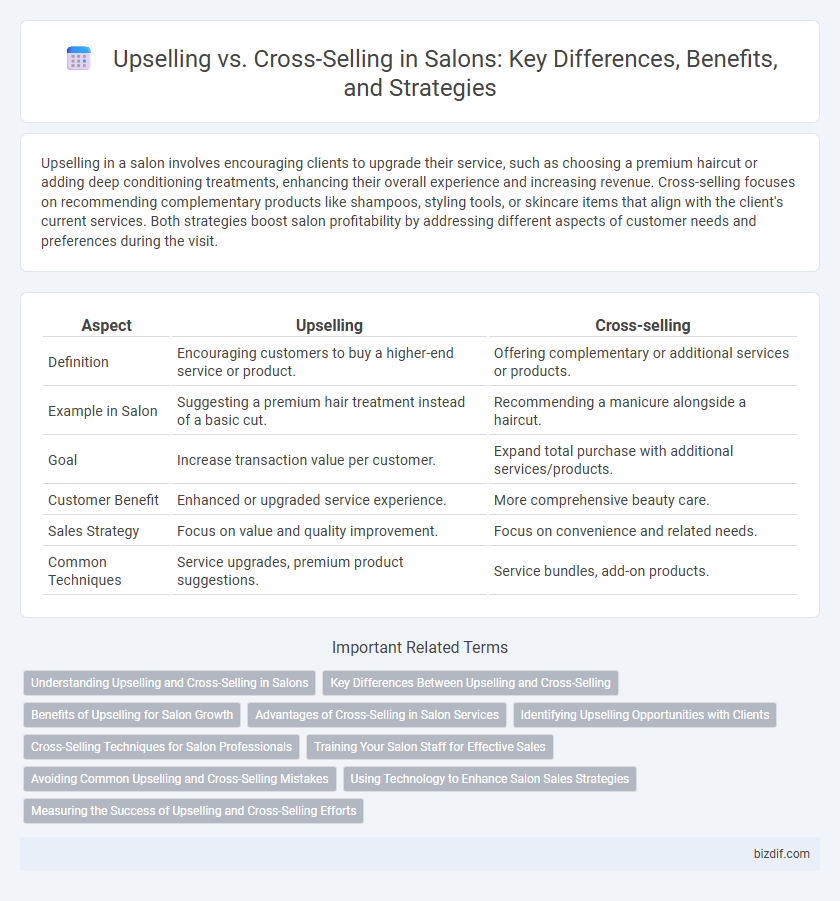Upselling in a salon involves encouraging clients to upgrade their service, such as choosing a premium haircut or adding deep conditioning treatments, enhancing their overall experience and increasing revenue. Cross-selling focuses on recommending complementary products like shampoos, styling tools, or skincare items that align with the client's current services. Both strategies boost salon profitability by addressing different aspects of customer needs and preferences during the visit.
Table of Comparison
| Aspect | Upselling | Cross-selling |
|---|---|---|
| Definition | Encouraging customers to buy a higher-end service or product. | Offering complementary or additional services or products. |
| Example in Salon | Suggesting a premium hair treatment instead of a basic cut. | Recommending a manicure alongside a haircut. |
| Goal | Increase transaction value per customer. | Expand total purchase with additional services/products. |
| Customer Benefit | Enhanced or upgraded service experience. | More comprehensive beauty care. |
| Sales Strategy | Focus on value and quality improvement. | Focus on convenience and related needs. |
| Common Techniques | Service upgrades, premium product suggestions. | Service bundles, add-on products. |
Understanding Upselling and Cross-Selling in Salons
Upselling in salons involves encouraging clients to upgrade to premium services or add-ons, such as choosing a deep conditioning treatment during a haircut appointment to enhance hair health. Cross-selling focuses on recommending complementary products or services, like suggesting a styling product or scheduling a facial alongside a manicure, to increase overall customer spend. Both strategies rely on understanding client preferences and needs to effectively boost salon revenue and improve customer satisfaction.
Key Differences Between Upselling and Cross-Selling
Upselling in a salon involves encouraging clients to purchase a higher-end service or product than originally intended, such as upgrading a basic haircut to a premium styling treatment. Cross-selling focuses on recommending complementary services or products that enhance the client's experience, like suggesting a deep conditioning treatment along with a haircut. The key difference lies in upselling increasing the value of a single service, while cross-selling boosts overall sales by adding related items.
Benefits of Upselling for Salon Growth
Upselling in salons enhances revenue by encouraging clients to choose premium services or products, increasing average transaction value. This strategy also strengthens client relationships through personalized recommendations that address specific needs. Consistent upselling boosts customer satisfaction and loyalty, driving sustained salon growth and profitability.
Advantages of Cross-Selling in Salon Services
Cross-selling in salon services enhances client satisfaction by offering complementary treatments tailored to individual preferences, increasing overall spend per visit. This strategy builds stronger client relationships and encourages repeat bookings through personalized service packages that address multiple beauty needs. Implementing cross-selling effectively can lead to higher revenue while optimizing appointment schedules and resource utilization.
Identifying Upselling Opportunities with Clients
Identifying upselling opportunities in a salon involves recognizing clients' current needs and suggesting premium services or products that enhance their experience, such as offering deep conditioning treatments during a regular haircut appointment. Salon professionals can analyze clients' hair type, condition, and style goals to recommend higher-end or add-on services like scalp massages or customized color treatments. Utilizing client history and preferences through salon software helps tailor personalized upsell suggestions that increase satisfaction and revenue.
Cross-Selling Techniques for Salon Professionals
Salon professionals boost revenue by implementing targeted cross-selling techniques such as recommending complementary hair treatments, retailing premium hair care products, and suggesting add-on services like scalp massages or eyebrow shaping during appointments. Leveraging personalized client insights and service history enhances the effectiveness of product and service suggestions, increasing customer satisfaction and repeat visits. Training staff to seamlessly integrate product education into client conversations ensures cross-selling efforts feel natural and relevant, maximizing salon sales potential.
Training Your Salon Staff for Effective Sales
Training your salon staff in upselling and cross-selling techniques increases revenue by encouraging clients to purchase premium services and complementary products. Emphasizing personalized recommendations based on client needs enhances customer satisfaction and loyalty. Implementing role-playing exercises and product knowledge sessions equips employees with confidence and expertise for effective sales.
Avoiding Common Upselling and Cross-Selling Mistakes
Avoiding common upselling and cross-selling mistakes in a salon involves understanding client needs and offering personalized recommendations that enhance their experience without appearing pushy. Staff should be trained to suggest complementary services, like a deep conditioning treatment with a haircut, while respecting client preferences to build trust and increase satisfaction. Tracking client purchase history and preferences allows salons to make relevant offers, preventing generic or irrelevant suggestions that can deter repeat business.
Using Technology to Enhance Salon Sales Strategies
Utilizing advanced salon management software enables personalized upselling by analyzing client history and recommending premium services tailored to individual preferences. Cross-selling becomes more effective through integrated POS systems that suggest complementary products during checkout, increasing average transaction value. Implementing AI-driven tools helps salons optimize both upselling and cross-selling opportunities, driving revenue growth while enhancing customer experience.
Measuring the Success of Upselling and Cross-Selling Efforts
Measuring the success of upselling and cross-selling efforts in a salon involves tracking key performance indicators such as average transaction value, customer retention rate, and the frequency of add-on service purchases. Analyzing appointment data and retail product sales reveals whether clients engage with recommended upgrades or complementary treatments. Client feedback and repeat visit metrics further help evaluate the effectiveness of personalized service suggestions in driving revenue growth.
Upselling vs Cross-selling Infographic

 bizdif.com
bizdif.com